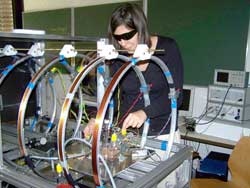New MRI technology to provide even better images of the inside of the human body

Xenon polarizer<br><br>photo/©: Institute of Physics / JGU
Over the past 30 years, magnetic resonance imaging has evolved into one of the most important imaging procedures in medical diagnostics. With a new approach based on the use of polarized gases and dissolved substances, it will in future be possible to produce even better quality images of the inside of the human body.
The German Federal Ministry of Education and Research (BMBF) will be providing EUR 1.3 million over the next three years to enable researchers at Johannes Gutenberg University Mainz (JGU) and the Max Planck Institute for Polymer Research to make the new procedure ready for the market.
A team of researchers led by Professor Dr. Werner Heil at JGU's Institute of Physics is working on a technology that is still in its infancy, but which has the potential for major innovation. The project entitled “Magnetic Resonance Imaging (MRI) Using Innovative Hyperpolarized Contrast Agents” will commence in December 2012. It will be funded by the German Federal Ministry of Education and Research as part of its high-tech strategy “Validating the Innovation Potential of Scientific Research – VIP.” This strategy is designed to provide support to researchers in making the crucial first steps to adapt new scientific findings for commercial applications.
Nuclear spin tomography, or magnetic resonance imaging (MRI) as it is more commonly known, provides highly detailed images of organs and tissues without exposing the patient to potentially harmful radiation. The drawback of this method, however, is its low sensitivity, which is currently being improved mainly through the use of ever stronger and more expensive magnets. During the project, the Mainz scientists will be taking a different approach with the aim of obtaining more accurate images and, consequently, new perspectives on diagnosing illnesses.
Normally, the body's endogenous hydrogen protons are used as signal generators for the purpose of MRI. But it is also possible to use hyperpolarized atoms for MRI, although in this case they need to be introduced into the body. In the 1990s, Werner Heil and the Mainz physicist Ernst-Wilhelm Otten developed a procedure in which the noble gas helium-3 is polarized by lasers. This polarized gas can be inhaled and provides high-resolution tomographic images of the lungs so that pulmonary disorders can be identified even in the very smallest of the bronchi. Taking this as their starting point, the scientists involved would like to improve the technology even further.
“However, the laser-induced polarization of noble gases alone is not sufficient for our purposes,” explains Heil. In addition to helium, it is also possible in principle to polarize xenon, another noble gas. However, its anesthetic effect means that its suitability for use in medical diagnostics is limited. The use of brand new substances as markers, such as polarized carbon-13, would open up new options for diagnosticians: Biological molecules and substances could be labeled by means of hyperpolarization so that their passage through the body could be directly monitored. Heil expects that it may also be possible to observe dynamic processes on the molecular level, such as certain metabolic processes.
At the same time, it is still necessary to overcome various obstacles before practical implementation can be considered. Except in the case of helium, it is not possible to maintain hyperpolarization over relevant periods. “This means we have to abbreviate the processes of polarization, administration, and detection so they can all be performed in no more than a minute at most,” states Heil. Moreover, getting the hyperpolarized substances into the bloodstream without harming the body is difficult. In an attempt to resolve this problem, the research team is working with membranes, such as those used in heart-lung machines or for dialysis. “We also need to separate the reaction chamber from the treatment room,” explains Dr. Peter Blümler, who is focusing on this aspect. “Perhaps we will also need several membranes to ensure that only the correct substances enter the blood.” However, it seems that a solution to another problem may have already been found. While the polarization of helium or xenon can be achieved with lasers, Dr. Kerstin Münnemann of the Max Planck Institute for Polymer Research has shown in her widely acclaimed work that it is possible to induce magnetic polarization in other substances by means of reaction with parahydrogen. The three scientists intend to combine their expertise to create novel diagnostic procedures at the point where physics, chemistry, and medicine intersect.
Media Contact
All latest news from the category: Medical Engineering
The development of medical equipment, products and technical procedures is characterized by high research and development costs in a variety of fields related to the study of human medicine.
innovations-report provides informative and stimulating reports and articles on topics ranging from imaging processes, cell and tissue techniques, optical techniques, implants, orthopedic aids, clinical and medical office equipment, dialysis systems and x-ray/radiation monitoring devices to endoscopy, ultrasound, surgical techniques, and dental materials.
Newest articles

Properties of new materials for microchips
… can now be measured well. Reseachers of Delft University of Technology demonstrated measuring performance properties of ultrathin silicon membranes. Making ever smaller and more powerful chips requires new ultrathin…

Floating solar’s potential
… to support sustainable development by addressing climate, water, and energy goals holistically. A new study published this week in Nature Energy raises the potential for floating solar photovoltaics (FPV)…

Skyrmions move at record speeds
… a step towards the computing of the future. An international research team led by scientists from the CNRS1 has discovered that the magnetic nanobubbles2 known as skyrmions can be…





















